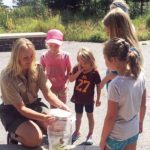Not only can you weather-proof your gear or make you camp bear-proof, you can also help your kids become “lost-proof.”
Kids get lost; adults get lost, too. Kids need to know that it’s something that can happen to the best of outdoorsmen and women—reassure them how easy it can be to become lost in the back-country and what they can do to be found again. Don’t be an alarmist, but reassure them that dealing with becoming disoriented/lost in the woods is all part of being a good, self-reliant outdoors person.
According to Search and Rescue (SAR) statistics, over 80 percent of lost victims are found within 12 hours. Nearly 60 percent became lost in the immediate vicinity of their campsite.
One of the best ‘lost-proofing’ programs is “Hug a Tree,” developed by SAR experts in British Columbia many years ago. It’s a list of tips and processes that help teach children what to do when lost.
Here’s a breakdown of some of the ways you can help children to either prevent becoming lost, or steps to take towards surviving harsh conditions and being found:
Stay on the Trail/Pick Out Landmarks
Encourage kids to stay on trails; don’t wander off. Teach kids to remember landmarks along the trail (big or unusual trees, rock outcroppings, other notable land features)—something to help them remember where they are if they become lost. If they can’t quickly find a landmark, teach them to stay put and hug a tree.
Wear Bright Clothing
Bright clothing makes them easier to be seen by searchers. Brightly-colored clothing/gear can be waved as a signal, too. Consider such clothing as part of a child’s own special outdoor wardrobe.
Carry a Plastic Yard Bag (a Bright One!)
Help kids make their own tent/raincoat from a huge plastic yard bag and encourage them to always carry it with them as their own personal emergency shelter. Tape a few heat packets to the bag for emergency warmth.
Stress the Importance of Seeking Shelter
They must keep dry and warm. Teach them how to make a simple shelter from a big pile of leaves or grass.
Make Noise
Kids (and adults) should always carry a whistle—not as a toy but as a signal they can use to make noise, louder and longer than they can by yelling. Let kids hear three loud blasts from a whistle to learn what that signal for help sounds like to searchers.
Don’t Be Afraid of Animals
Animals are usually always more afraid of people and will run off. Teach them that if they hear or see an animal, to stay still and make loud noises to scare them away.

Make a Foil/Photo Footprint
Which footprint is your child’s? Have kids wear a select pair of shoes when outdoors and take a photo of each sole. You can also cut a piece of aluminum foil and lay it on a medium soft surface. Have your child step squarely onto the center of the foil to make a distinct impression. To distinguish the sole from others, cut an identifying notch into a section of the tread. This image can be photographed and filed. Searchers can use this footprint to compare it against others found in the area.
Don’t Talk to “Strangers?”
All parents warn their children to never talk to strangers. Let them know that someone trying to find them is a friend, and will know their name and be calling it out. Come up with a special nickname or “secret word” to share that only someone who is trying to help them will know.
Kids wander off for many reasons, and some evade searchers because they fear punishment for being lost in the first place. It’s important to reassure children that if they become lost, people will be looking for them—and you just want them to be safe.
Part of introducing your child to the great outdoors is helping them become comfortable and confident in that diverse environment. Show them how being brave, calm and using their heads is very important.
Helping kids understand the outdoors and teaching them how to be self-reliant goes a long way to building confidence in scary situations.






